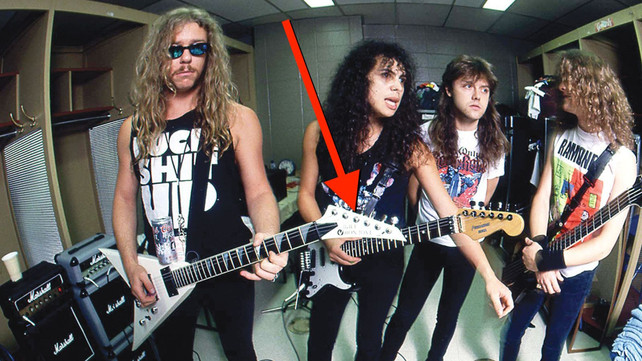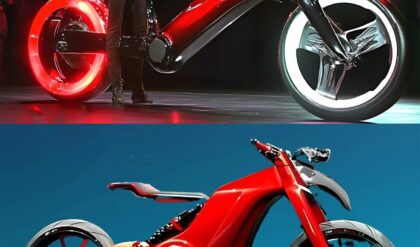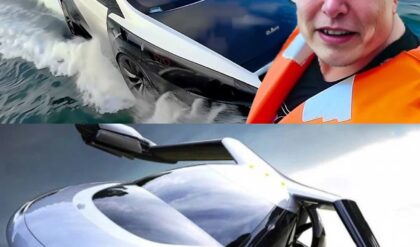Story Behind James Hetfield’s Jackson Guitar and Its Bon Jovi-Themed Stickers
An exclusive book excerpt from James Hetfield’s Messengers: The Guitars of James Hetfield.

Metallica’s James Hetfield has played quite a few memorable guitars over the years, such as the black ESP Of Wolf & Man, which was spotted throughout the seemingly never-ending tour in support of The Black Album. But also some forgotten or overlooked instruments, such as his Kill Bon Jovi Jackson King V.
All of Hetfield’s six-strings have been extensively documented in the exceptional new book, Messengers: The Guitars of James Hetfield, by Hetfield himself.
Published by Permuted Press, this 400-page hardcover book is chock-full of photographs of each of Hetfield’s instruments, with many also featuring memories and insight directly from Metallica’s longtime singer and guitarist.
In this exclusive excerpt, Hetfield discusses his aforementioned white 1985 Jackson King V, otherwise known as Kill Bon Jovi or KBJ for short, which he recorded one of rock’s all-time classic albums with.
King
The first thing to note about the Jackson King V, otherwise known as Kill Bon Jovi, is that the model was named after Robbin Crosby of Ratt who had the nickname “King.”
Photo credit: Ross Halfin
I had talked with those guys before as we’d hung out and done shows together. I probably first saw that guitar when I was talking to him at some point. The main reason it caught my eye, and that I got that guitar in the first place, was because it was bigger. Robbin was a big guy, 6′ 4″ or something. He was huge. The regular V looked tiny on him, and I thought it was pretty exciting to have this bigger V. I liked the big jumbo frets.
A lot of the LA guitar players were playing faster. That’s right around the time when scalloped necks became a big deal with Yngwie Malmsteen and some of the shredders. I’m pretty sure Kirk had a guitar that had a scalloped neck, but I didn’t find that appealing. Being the rhythm player, I rarely went above the twelfth fret, so, for me, it was all about the speed. I wanted all my guitars to play fast, but there were certain ones that played faster than others. Some guitars sound fast but don’t play fast, and some guitars play fast but don’t sound fast. They’re not tight and punchy. Maybe this was a little lighter, plus it looked like a weapon, which was always kind of cool.
Jackson guitars were a big deal at that point, and we had some connection with them, although, to be honest, I think we might’ve gone ahead and bought this one because the connection wasn’t strong enough yet. The other thing about Jackson is that they were pretty popular, and all over the West Coast. We were a West Coast band, so I got it. And when I got the guitar, I really wanted it to be nice and work, which it obviously did in the immediate term for what we were after.
Master of Puppets
KBJ was at Sweet Silence Studios in Copenhagen for the recording of Master of Puppets and also went on the Damage, Inc. Tour, but truth be told, I never really ended up liking that guitar like I’d hoped I would.
Photo credit: Ross Halfin
It plays okay, and I liked having a headstock the same color as the guitar, but it never felt completely right. I’m not sure why. Maybe it was just a little too pointy. It’s pretty strange when you think about it, because Master Of Puppets is obviously one of the more highly regarded albums of our Cliff days, and a lot of it was recorded using KBJ, so it’s interesting to arrive at that conclusion.
Denmark
I know that overall we had a difficult time getting good sounds in Denmark. Ride the Lightning was tough, and Master of Puppets was just as tough. We did not have the right gear, and we tried all the different amps that were available.
Copenhagen was not the Mecca of studios or musical gear. We pretty much tried every single amp in Copenhagen and must’ve ended up with something that we were somewhat happy with for Master of Puppets.
KBJ’s got a unique headstock, almost like an Explorer, and a V body, so it was a combination of the two things that were appealing to me. In some ways, it was my return to the V. Kirk had that black Jackson, the Randy Rhoads V, and that was just a fad for us at the time, just like all the pickups. “Why did you have a Dirty Fingers? Why did you have a Seymour Duncan?”
Well, those were the next “thing.” You heard from some other guitar player in a metal band who said they used them, and that was the signal it was cool. I remember Ross the Boss from Manowar handing me a pickup saying, “This is what I use. Here, you should try ’em.” It was like that, brothers helping each other out with certain pickups and all kinds of equipment.
Photo Credit: Scott Williamson
I remember when I first got it, just looking at the way the knobs were set up and where the toggle switch was. They were in a horrible place for me. I swapped them so I could at least get to the toggle switch because, before that, the knob was in the way, just not a great design.
Then there’s the distance between the tailpiece and the bridge, which is too long and somehow didn’t feel tight enough for me. I felt that the pickup was too far away from the back bridge, so I had a luthier go in, router out the pickup hole, and move it more towards the bridge.
I thought that would help with the tightness of the crunch, but it didn’t. From the beginning, there was a lot of love put into that guitar to make it sound right and try to make it work out.
Kill Bon Jovi
Funnily, I always thought this guitar was preserved better than any of my guitars, and then I realized that the headstock snapped around ’87, and there are multiple cracks throughout. it just proves that all guitars are subject to abuse, even the ones you thought you took better care of.
Photo credit: Zach Harmon
As for the Kill Bon Jovi sticker, like the You Haven’t Got A Prayer sticker, it was given to me by someone on the road, and we thought it was funny, so I thought, Let’s put it on there. It was right after Donington when there was that whole thing with Bon Jovi flying over the crowd in a helicopter while we were playing.
Photo Credit: Scott Williamson
I believe that the English are a little more aware of “piss takes” and stuff like that. Most of the press were asking if we were pissed off when Bon Jovi flew over the crowd, but it was like, “Was that who that was?” I really didn’t care. But it was almost like you were supposed to be pissed off, so that sticker showed up, and it meant nothing really except, “Hey, don’t screw with us.”
Photo Credit: Scott Williamson
“Sorry for the sticker”
We made amends to each other. He said, “Hey, sorry for flying over,” and I said, “Sorry for the sticker.”
It meant nothing except they were the antithesis of what we wanted to be and vice versa. We were the scrubby punk metal gutter drunks that they weren’t. They were what they were, big hair, fancy clothes—all the stuff that we were fueled by at the time. Hair metal was “the enemy” so it’s obviously ironic that Robbin Crosby, who inspired this guitar, was part of that.
I can’t specifically detail the exact time KBJ went into retirement, but there’s that moment when you open the case, look at it and go, “Ah, it’s time to move on. What’s next?” I think for KBJ, that was around the end of ’87. It went into storage for a good while, which meant it went to my apartment at the time and subsequently moved from place to place until I got my first house and was able to have a guitar closet. It was in there or under my bed.





